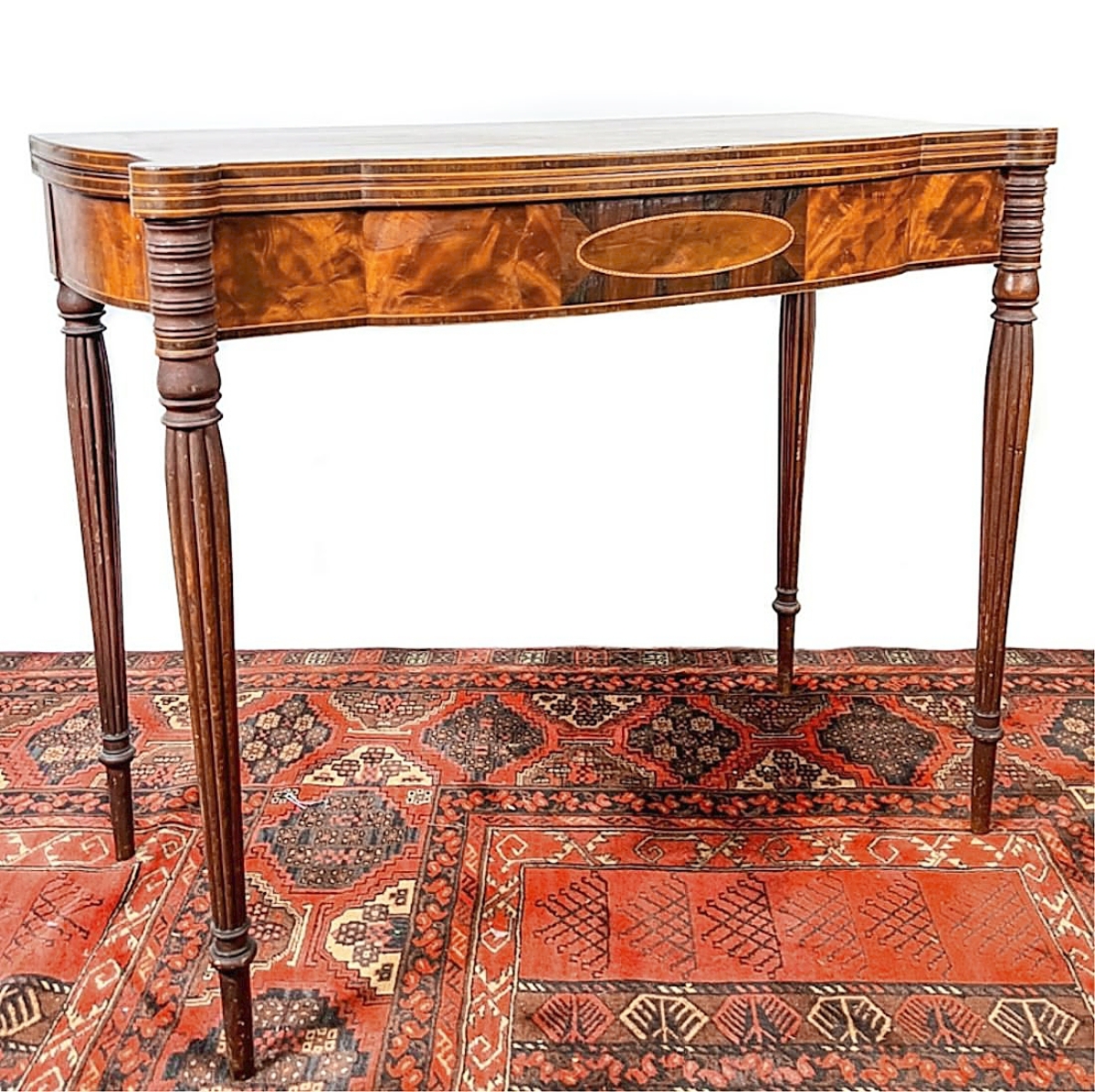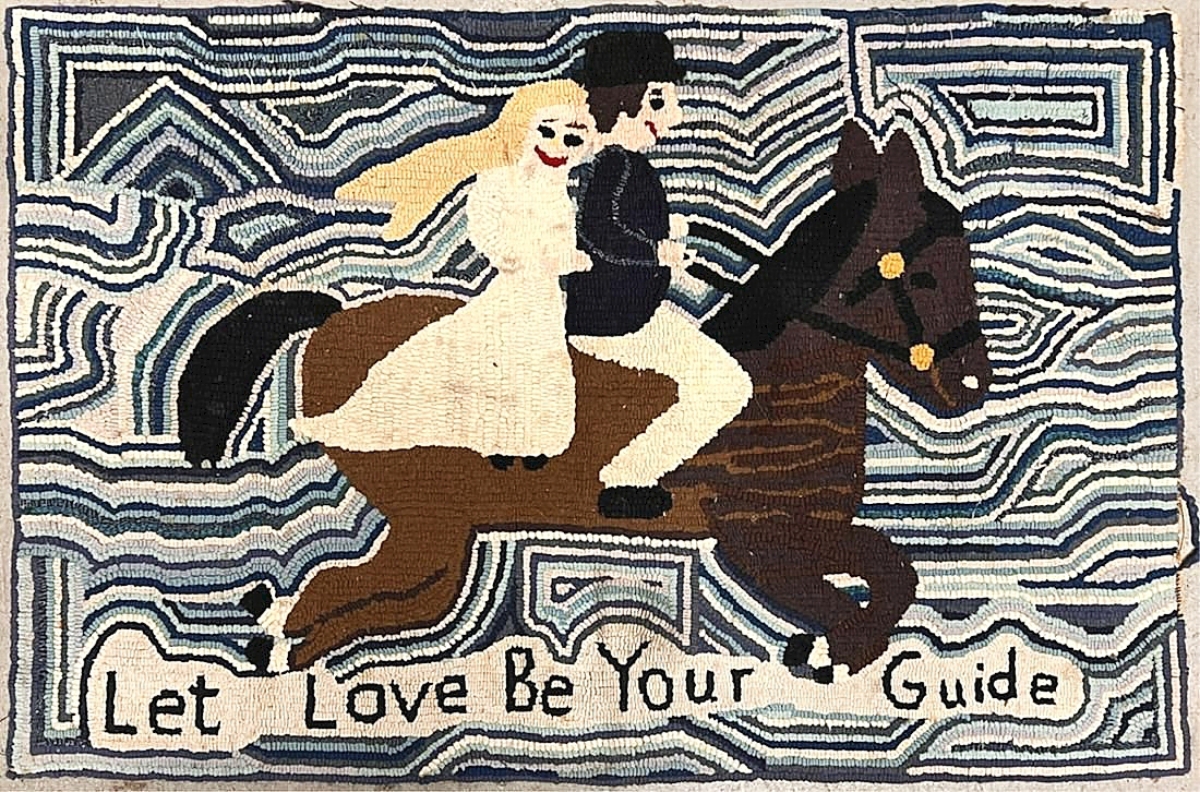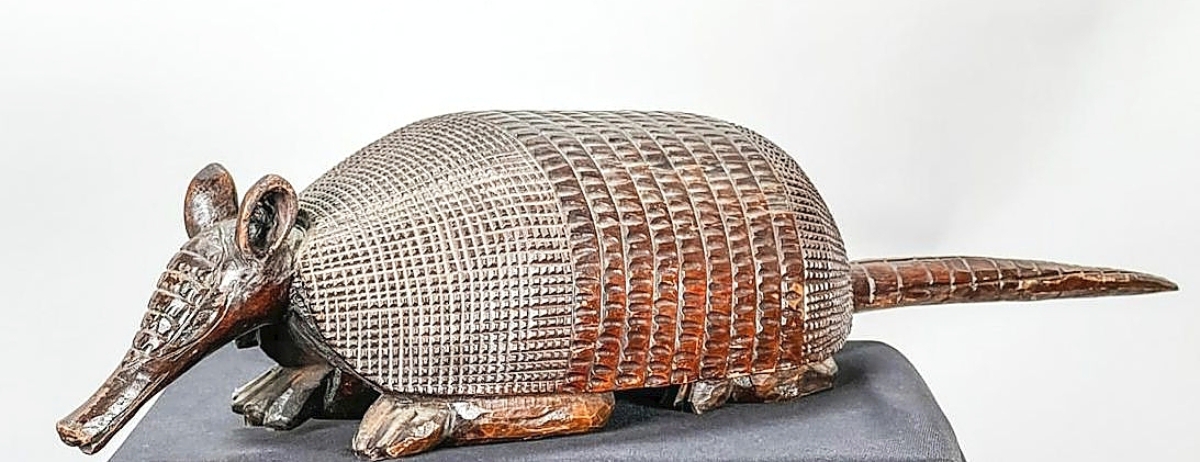
The highest priced item in the sale was this large circa 1920 Heriz carpet. It was 18 by 11½ feet and reached $8,680.
Review and Onsite Photos by Rick Russack, Additional Photos Courtesy John McInnis Auctions
AMESBURY, MASS. – It’s not unusual for auctions to be spread over two days, sometimes three and sometimes more. But John McInnis, on the weekend of September 10-11, conducted four separate auctions. On Saturday, he conducted a live gallery sale of Americana with more than 600 lots, reminding bidders that “if you don’t buy it, you can’t sell it.” The sale was livestreamed, and bidding was available on two internet platforms, along with phone and absentee bids, On Sunday, he conducted three separate, online-only timed sales with more than 500 lots between them. These were themed sales, with all the merchandise coming from one enormous collection. A few days later, he had another themed sale of more than 300 lots. That says two things: one is that McInnis has organized his company to deal with quantity in a short period of time, and it also indicates the enormous amount of merchandise coming into the marketplace now. McInnis isn’t the only auctioneer with one sale rapidly following another. McInnis has been able to do this without increasing staff. A few days before the weekend’s sales, he commented, “We’re only able to do this because everyone really works well with everyone else. The group has been together for a long time, they each know what they have to do, and they each pitch in to help and get done what needs to be done.”
The live gallery sale on Saturday showed the strength of the market for trade signs, grain-painted furniture, Oriental carpets, Windsor chairs, paintings – especially those of sheep – and folk art. There was also a large collection of sad irons. One of the themed online sales on Sunday was focused on Asian items, ceramics, bronzes and more. Another focused on a selection of “International” items, including Judaica, items from Russia, ethnographic African items, along with Alaskan and Native American objects. The third themed sale included a selection of contemporary crafts such as studio pottery, a collection of artisan-made kaleidoscopes, art glass and much more. The material for these three sales came from the collection of Dr Allan Bezan (1938-2001), who was chief resident at NY Hospital, Cornell Medical Center and at Tufts NE Medical Center. He was a strong supporter of artists and artisans across the United States and filled his home with items that met his criteria. These online sales were managed by Jay Williamson, who has been with John McInnis for about 25 years.
The crowd in the gallery was not large but it comprised active bidders. One dealer in the room commented that he was not able to purchase any signs, a specialty of his, because of the high prices. Most popular was a wooden 36-inch double-sided sign, painted black, lettered “Hat and Caps.” The gold leaf lettering was outlined in green. It finished at $4,340. Another double-sided sign, this one for the J. Elwood Lee pharmaceutical company, earned $3,410. The business was located in Conshohocken, Penn., and was purchased by Johnson & Johnson, with Lee becoming a board member.

The sale included several trade signs. This one, a 36-inch double-sided wooden sign, painted black, lettered “Hats and Caps,” reached $3,430, the highest price of the selection.
The several paintings of sheep were consigned by the same person, and bidders liked them. “Grazing Sheep” by John Joseph Enneking (1841-1916), finishing at $4,650, drew the most competition. It depicted a flock of several unshorn grazing ewes with their lambs, one of which was shown nursing from its mother. A painting of a single resting lamb by Edmund Hawthorn brought $1,860. A pair of small paintings, one depicting rams and the second of ewes, by Nineteenth Century artist J.W. Prestley went out for $868. Other paintings included a St Marks, Venice, scene, which sold for $3,410. It was cataloged as a “Twentieth Century painting from a Rockport artist who painted Italy in the manner of Canaletto.” The online catalog also mentioned condition issues and included seven photographs so that prospective bidders could form their own opinions.
The two highest prices of the sale were achieved by large Oriental carpets. A larger than room-sized circa 1920 Heriz, 18 by 11½ feet, brought $8,680. A large Hamadan carpet, more than 16 by 10 feet, brought $5,680.
Folk art included two interesting Twentieth Century hooked rugs. Perhaps made as a wedding gift, one showed a bride and groom riding a black horse, with an abstract background. It said, in bold letters, “Let Love Be Your Guide” and sold for $744, well over the estimate. The second rug of the same period needed a buyer who had graduated from the University of New Hampshire, or had children attending the school. It was brightly colored and had a simple striped design with the letters “UNH.” Obviously, the market for this one was narrow, and it sold for $124. As McInnis was selling a full-bodied copper rooster weathervane, he commented, “I don’t think I’ve ever seen one this small.” With its original arrow, it was only 15 by 21 inches. It sold for $496.

The North Shore turret-top gaming table bore the signature of “Edmund A. Lewis,” but who he was is not known. With original surface and some condition issues, it sold for $3,100.
Deservedly bringing one of the highest prices of the furniture selection was a country piece, a Nineteenth Century grain-painted two-drawer blanket chest with bold red and black designs. It sold for $3,100. The same price was achieved by a Federal period turret-top game table that had certainly been made for a different market. It was a North Shore example with turned reeded legs with inlaid decoration and rosewood panels. It was signed “Edmund A. Lewis,” but who Lewis was is unknown. The internet lists a family history of an Edmund Lewis of Lynn, Mass., but provides no more information. The table had its original surface and some condition issues. Another Federal period piece, a four-drawer inlaid bowfront chest with bird’s-eye maple veneer and a drop panel with an inlaid eagle realized $2,356. A cherry tall case clock signed “Newport” on the dial reached $1,488. With a moon-phase movement, the simple case appeared to never have had fretwork or finials.
The sale was not short on unusual items. One was a Shaw & Clark closed tower sewing machine, which earned $1,364. The hand-cranked machine was produced between 1860 and 1870, and this example included its original red-painted pine case, The company was based in Biddeford, Maine, and was on the losing end of a patent infringement suit in 1864. The company had an interesting relationship with patent law and further information is available on the Internet. The sale also included a collection of more than 100 sadirons, flat irons and trivets. Most were sold in lots, some singly. Most sold inexpensively, $186 being earned by a group of seven collar and cuff brass irons. The highest price, $217, bought a group of three brass slug irons.
Sunday’s online-only sales drew strong bidding. One of the three sales was devoted to Asian material. Two of the lots in this sale resulted in extended bidding battles that lasted about two hours, and other items also resulted in long battles. AuctionNinja was the online platform used. In these sales, almost everything starts with a bid of $1, and descriptions are usually sparse, but McInnis included several photos of each item. If a bid comes in within five minutes of closing, bidding is extended on that item for an additional five minutes. The system is designed to allow bidders to raise bids if they wish, but it can also mean that some lots remain open for bidding for extended times. That’s what happened with a vase cataloged simply as “sang de boeuf porcelain bottle vase.” It was marked with Chinese characters, which were pictured. Bidding closed on this vase approximately two hours after the sale began and it brought $1,955. AuctionNinja noted there were 88 bids. The other piece was also cataloged simply, “large porcelain bottle vase, depicting a flowering tree, peaches and bats. signed. 21 inches Condition: Good.” There were 68 bids, finally ending at $1,553. Several other items in the sale also drew numerous bids. The sale devoted to artisan and craftsmen wares was topped by a studio pottery “feelie” vase by Rose and Ernie Cabat. She was a well-known midcentury potter who developed her signature “feelie” glazes in the mid-1960s. She died at the age of 101 in 2015. Her work is in numerous museum collections. The piece that McInnis had, about 4 inches tall, was purplish in color and sold for $431. It drew 43 bids.

As John McInnis was selling this crowing rooster weathervane, he said, “I don’t think I’ve ever seen one this small. It was only 21 inches long and realized $496.
A few days after the sale, McInnis commented, “It’s such a great time to be buying furniture, but it’s hard to get that message across. Covid brought a lot of new, younger buyers into the marketplace but they’re missing the boat on some of the great Eighteenth and Nineteenth Century furniture. We’re all pleased with the way the weekend went. The online-only sales did well, and we finished up at around $400,000. Can’t complain about that.”
Prices given include the buyer’s premium as stated by the auction house. For more information, www.mcinnisauctions.com or 800-822-1417.



























